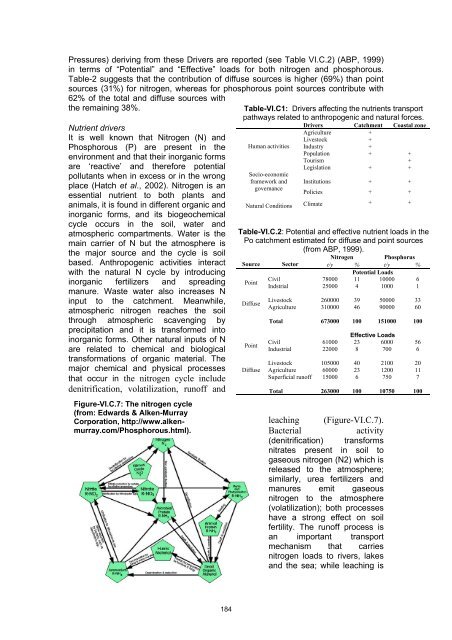Climate Change and the European Water Dimension - Agri ...
Climate Change and the European Water Dimension - Agri ...
Climate Change and the European Water Dimension - Agri ...
You also want an ePaper? Increase the reach of your titles
YUMPU automatically turns print PDFs into web optimized ePapers that Google loves.
Pressures) deriving from <strong>the</strong>se Drivers are reported (see Table VI.C.2) (ABP, 1999)<br />
in terms of “Potential” <strong>and</strong> “Effective” loads for both nitrogen <strong>and</strong> phosphorous.<br />
Table-2 suggests that <strong>the</strong> contribution of diffuse sources is higher (69%) than point<br />
sources (31%) for nitrogen, whereas for phosphorous point sources contribute with<br />
62% of <strong>the</strong> total <strong>and</strong> diffuse sources with<br />
<strong>the</strong> remaining 38%.<br />
Nutrient drivers<br />
It is well known that Nitrogen (N) <strong>and</strong><br />
Phosphorous (P) are present in <strong>the</strong><br />
environment <strong>and</strong> that <strong>the</strong>ir inorganic forms<br />
are ‘reactive’ <strong>and</strong> <strong>the</strong>refore potential<br />
pollutants when in excess or in <strong>the</strong> wrong<br />
place (Hatch et al., 2002). Nitrogen is an<br />
essential nutrient to both plants <strong>and</strong><br />
animals, it is found in different organic <strong>and</strong><br />
inorganic forms, <strong>and</strong> its biogeochemical<br />
cycle occurs in <strong>the</strong> soil, water <strong>and</strong><br />
atmospheric compartments. <strong>Water</strong> is <strong>the</strong><br />
main carrier of N but <strong>the</strong> atmosphere is<br />
<strong>the</strong> major source <strong>and</strong> <strong>the</strong> cycle is soil<br />
based. Anthropogenic activities interact<br />
with <strong>the</strong> natural N cycle by introducing<br />
inorganic fertilizers <strong>and</strong> spreading<br />
manure. Waste water also increases N<br />
input to <strong>the</strong> catchment. Meanwhile,<br />
atmospheric nitrogen reaches <strong>the</strong> soil<br />
through atmospheric scavenging by<br />
precipitation <strong>and</strong> it is transformed into<br />
inorganic forms. O<strong>the</strong>r natural inputs of N<br />
are related to chemical <strong>and</strong> biological<br />
transformations of organic material. The<br />
major chemical <strong>and</strong> physical processes<br />
that occur in <strong>the</strong> nitrogen cycle include<br />
denitrification, volatilization, runoff <strong>and</strong><br />
Figure-VI.C.7: The nitrogen cycle<br />
(from: Edwards & Alken-Murray<br />
Corporation, http://www.alkenmurray.com/Phosphorous.html).<br />
184<br />
Table-VI.C1: Drivers affecting <strong>the</strong> nutrients transport<br />
pathways related to anthropogenic <strong>and</strong> natural forces.<br />
Drivers Catchment Coastal zone<br />
<strong>Agri</strong>culture +<br />
Human activities<br />
Livestock +<br />
Industry +<br />
Population + +<br />
Tourism +<br />
Legislation + +<br />
Socio-economic<br />
framework <strong>and</strong> Institutions + +<br />
governance<br />
Policies + +<br />
Natural Conditions <strong>Climate</strong> + +<br />
Table-VI.C.2: Potential <strong>and</strong> effective nutrient loads in <strong>the</strong><br />
Po catchment estimated for diffuse <strong>and</strong> point sources<br />
(from ABP, 1999).<br />
Source<br />
Point<br />
Nitrogen Phosphorus<br />
Sector t/y % t/y %<br />
Potential Loads<br />
Civil 78000 11 10000 6<br />
Indstrial 25000 4 1000 1<br />
Livestock 260000 39 50000 33<br />
Diffuse <strong>Agri</strong>culture 310000 46 90000 60<br />
Point<br />
Diffuse<br />
Total 673000 100 151000 100<br />
Effective Loads<br />
Civil 61000 23 6000 56<br />
Industrial 22000 8 700 6<br />
Livestock 105000 40 2100 20<br />
<strong>Agri</strong>culture 60000 23 1200 11<br />
Superficial runoff 15000 6 750 7<br />
Total 263000 100 10750 100<br />
leaching (Figure-VI.C.7).<br />
Bacterial activity<br />
(denitrification) transforms<br />
nitrates present in soil to<br />
gaseous nitrogen (N2) which is<br />
released to <strong>the</strong> atmosphere;<br />
similarly, urea fertilizers <strong>and</strong><br />
manures emit gaseous<br />
nitrogen to <strong>the</strong> atmosphere<br />
(volatilization); both processes<br />
have a strong effect on soil<br />
fertility. The runoff process is<br />
an important transport<br />
mechanism that carries<br />
nitrogen loads to rivers, lakes<br />
<strong>and</strong> <strong>the</strong> sea; while leaching is













